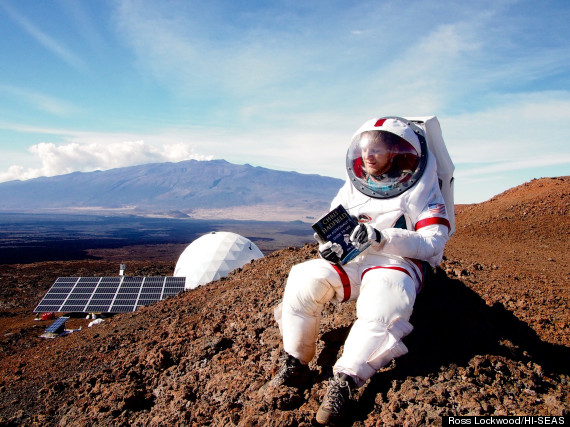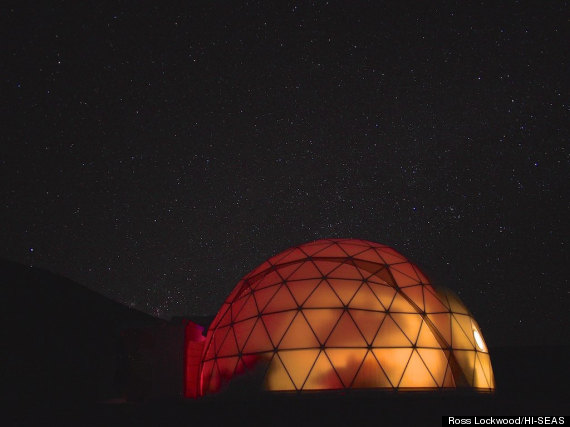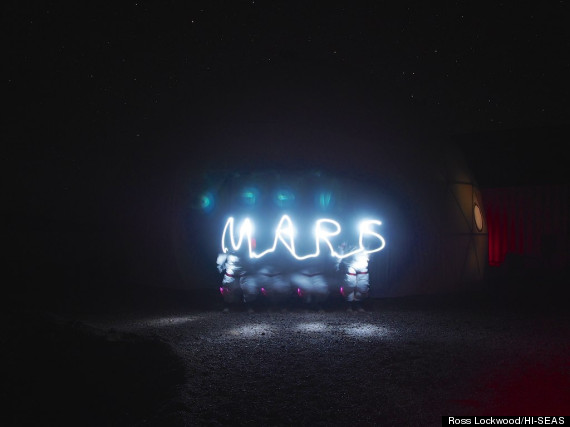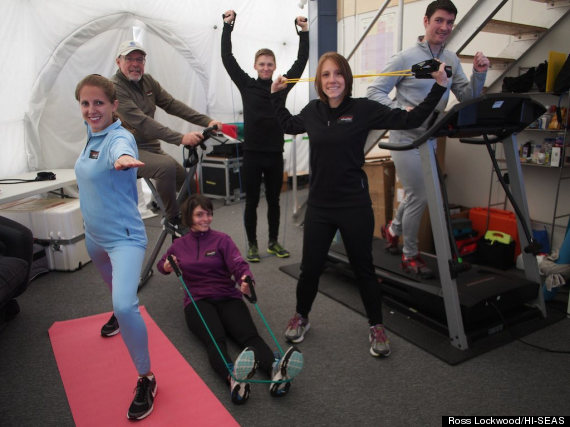If you took a six-month or two-year (or maybe even a one-way) trip to Mars, what would your life really be like once you land? How would you exercise? What would you eat? And, laundry? Pssh. How would you even have water in the first place?
Scientists participating in the Hawaii Space Exploration Analog and Simulation (HI-SEAS) mission here on Earth have spent the past four months studying these questions in a Martian-like environment in Hawaii. They opened up their communication systems to answer questions on Sunday in Reddit’s Ask Me Anything, and by the looks of it, they may have gone a little cooky.
(Story continues below.)
The HI-SEAS program, which is funded by NASA and organized by the University of Hawaii, simulates the living conditions and challenges future astronauts may face on Mars. It was designed to study how a crew adjusts to a Mars-like habitat both mentally and physically.
The "Mars" mission crew, made up of six researchers, is stationed in a 1,000 square-foot domed habitat a mile up a rocky road on Hawaii Island’s Mauna Loa volcano -- a landscape similar to the Tharsis region on Mars. The mission began March 28 and ends this Friday, July 25.
In the AMA Q&A, conversation ranged from how to deal if somebody dies, to the perils of boredom, to whether a Mars resident would be 100 percent vegetarian.
Below, we’ve listed some of our favorite insights from the AMA.
What do you people do for fun?
Ross Lockwood (crew member): Movie nights, boardgames, exercise all top the list of things we do for fun. We don't have a lot of spare time, but I count work as part of the fun as well. Planning EVAs, preparing food, even chores - these are all enjoyable activities.

Let's face it -- space can be dangerous, no matter the precautions and training, so I'm wondering: has there been any training/discussion on how to cope with severe medical crises, or -- heaven forbid -- death, while far from Earth or even on the Martian surface?
Jack Cope (mission support): Good point, it certainly is dangerous and we do need to prepare for everything! During this mission we have not studied medical crises per say but we did have a simulation where the crew were asked to prepare an emergency shelter outside the habitat in a lava tube for rapid evac during increased solar partial activity. I am sure that we will expand on this during our subsequent (and longer) missions as it is hugely important.

How efficient is your water recovery/resupply process? I also wonder about laundry. Laundry uses water, and needs a lot of space to hang clothes. Even tumble dryers aren't an answer to everything. And laundry generates humidity, which generates other issues.
Joseph Gruber (mission support): Great point and this is one of the areas being researched in the HI-SEAS missions through the NASA Johnson Space Center Advanced Clothing Study. One of the goals is long-duration wear so that laundry is less of a concern than here on Earth. Even on the International Space Station clothing is worn for a long duration then thrown away as opposed to doing laundry.

Have you considered transportation on the surface [of Mars], for a long stay? If you are there for three years, you could travel say, 1,000 km over the surface, and back again, if you have a motorized Mars buggy or a rocket powered hopper of some sort.
Ross Lockwood (crew member): The HI-SEAS mission does geological work while out on EVA to explore and identify possible natural structures for human habitation and materials storage. However, we are very limited to what we can actually do in the field, mostly out of respect for the natural environment around the habitat. The lava fields themselves are almost impossible to traverse on foot, and would be impossible and perilous to traverse in any type of vehicle (4-wheel drives included). So as far as the HI-SEAS mission is concerned, we've all but eliminated the possibility of vehicular travel in this study. With that being said, there are a lot of groups exploring the idea of small buggies (think MDRS) and robotic vehicles (think PICSES).

How would you suggest spacecraft habitat designers improve the experience of going to or staying on Mars?
Gary Strawn (mission support): How can we improve the experience of staying on Mars? Well, I can think of a lot of really important things like bringing air, water, food and a radiation shelter. What I worry about is the potential to forget little things like zippers that can be operated while wearing large space suit gloves, water jugs with special lids and handles and some kind of spacesuit backpack or fanny pack. Hopefully, when we send humans to Mars, we will have done enough missions like HI-SEAS that we'll remember to bring the really important stuff like extra toilet paper.

When do you think we'll actually be doing this on Mars? What is the biggest accomplishment you see us achieving in our very near future?
Jack Cope (mission support): In the near future, I'm again looking to perhaps someone sending a man to the Moon and actually staying there for a good amount of time (we only scratched the surface with Apollo). I think we need something like this to bring back the excitement we had during the 60s; probes and rovers may bring you a lot of science but there is nothing like looking up into the sky and knowing 'someone like me is up there.'

